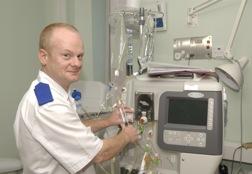This case study was joint winner of the 2013 Green Nephrology Awards.
The project was implemented by a multi professional team, comprising Gary Carlisle (ward manager), David Croft (chief renal technologist) and Dr John Stoves (consultant nephrologist) at Bradford Teaching Hospitals NHS Foundation Trust.
Setting/Patient Group: Dialysis Unit
Issue to be addressed:
Haemodialysis consumes water, acid and bicarbonate.
Patients dialysing using a Fresenius 5008 machine were using either 500mls/min or 800mls/min dialysate flow.
However, the autoflow facility allows a dialysate flow rate 1.5 times the blood flow rate enabling possible reduction in the consumption of water, acid and bicarbonate during haemodialysis and use of smaller 650g bibags rather than 900g bibags.

Intervention:
- Staff education of planned change and how to activate autoflow facility.
- Systematic review of prescriptions to identify patients who would continue to require 900g bibags (i.e. those with 500mls/min blood flow or greater than 4 hours treatment time).
- Stocks of 650g bibags were increased and a switchover date set.
Outcome:
Clinical
- No reduction in delivered dose of dialysis.
Environmental
- 9% reduction in water usage for haemodialysis.
- 9% reduction in use of acid concentrate, use of smaller Bibags
- Estimated annual carbon savings of approximately 3,715kg CO2e
Economic
- Estimated annual financial savings of £11,524 from bibag procurement and water/concentrate use
Key learning point
Use of Autoflow to determine Dialysate flow rate has the potential to reduce dialysis consumable costs but may impact on dialysis adequacy in patients with lower blood flow rates hence need to pay close attention to them.
Please log in or sign up to comment.